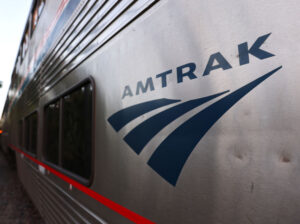Alice Can't Yet Ride To Amtrak's Rescue
Even though Railware's claims survived Amtrak’s motion to dismiss, there is still a long way to go before Railware can claim ultimate victory.

(Photo by Mario Tama/Getty Images)
As summer chugs along to a close, Americans are doing what they can to squeeze out the last bit of enjoyment before the seriousness of September surfaces. For many, this upcoming weekend will be one of travel to a beach or a lake or just somewhere different from one’s year-round locale. Some will fly, many more will drive, and there may even be a few hardy souls that ride the rails. As a denizen of the Northeast, I am well-acquainted with the pros and cons of travel by Amtrak for business purposes. Using Amtrak for pleasure travel? In my case, that has not yet happened. But it is still good to know that Amtrak is an option, as I enjoy the ease of travel by train down to Washington for a work-related jaunt over flying or driving.
Anyone that has taken an Acela or even a regional non-Acela Amtrak train between Boston and D.C. knows how crowded the rails in the Northeast Corridor can be, especially where the tracks overlap with those used by commuter railroads. Between Newark’s Penn Station and its big brother in New York, for example, there are often delays getting into the tunnel between the two cities, because of train traffic. Such delays are nowhere near as frequent or terrible as your typical highway traffic on I-95, or those crossing into Manhattan via the Lincoln Tunnel, but they do serve as a reminder that even railway tracks around major metropolitan areas are not immune to congestion. While such congestion is inconvenient for both riders and train staff, it can be even more of an issue when a heavily-used track needs repair work. On busy rail routes, that repair work often happens around the regular use of the tracks by trains, which increases the risk that maintenance workers could have a tragic encounter with a train speeding along to its destination while the worker is still on the track.

LawPay Pro Offers Upgraded Time And Billing Essentials
Avoiding accidents with trains and maintenance staff, therefore, is a priority for railroad operators. A traditional means of increasing track safety during maintenance is to use a remote dispatcher — a worker who blocks and unblocks track sections being serviced — operating a centralized control system. But placing everything in the hands of the remote dispatcher could still lead to mistakes, such as a dispatcher thinking work was complete while the maintenance staff is still finishing up. To make things even safer, a principal at a leading railway management firm came up with a better solution. In his implementation, before a rail section or block could be cleared, the dispatcher would need to receive a confirmation from the maintenance team in the field via electronic means. His innovation led to the issuance of several patents, with two of those patents asserted by his employer Railware in a Southern District of New York case against Amtrak that was filed in June 2022.
In response to the infringement allegations, Amtrak followed a well-worn defense strategy, filing a motion to dismiss asking for a finding that the two asserted patents were ineligible under Alice and its progeny. After full briefing and two post-briefing submissions of supplemental authority — with the latter submissions a prime example of the ever-changing case law landscape around ineligibility concerns in patent cases — the SDNY’s Hon. Katherine P. Failla ruled on the motion in an opinion issued on August 23. There, the court disagreed with Amtrak that the asserted patents were directed to abstract ideas, but were rather “directed to using a specific technique to solve the problem of trains entering sections of track on which workers are performing maintenance — namely, arming railway workers with an interactive device that provides them with a unique release code that they must send to central control to remove a railroad block.” Before the court got into the meat of its opinion, however, it also took a proverbial side track to find that the presumption of validity was not much of a prophylactic against Alice challenges, as the “Court gives no weight to the fact of the Asserted Patents’ issuance beyond holding Defendant to its burden.”
Despite that finding negating the value of the presumption of validity, Railware was able to survive the Alice inquiry. First, the court looked at whether the claimed inventions — which depended in large measure on sending codes over a communications link — were directed to an abstract idea. After a scenic tour of the Alice case law mountain range, the court concluded that these patents were not, as they did “not only describe a desired result, but explain how to achieve it.” Rather than just being directed to the abstract idea of sending codes between two participants in a system, the claims provide “a technological solution to the problem of trains entering tracks before railway workers have vacated them: including those workers in the process of blocking and unblocking tracks through the additional of a personalized, interactive user interface and code system to conventional centralized railroad control systems.” Likewise, the court credited the improvements to communication protocols between maintenance workers and remote dispatchers in a centralized railroad management system for important safety purposes as representing a technological leap over the prior art — leading to victory for the plaintiff on Alice step two as well.
Ultimately, even though the claims survived Amtrak’s motion to dismiss, there is still a long way to go before Railware can claim ultimate victory, or even earn itself some free Amtrak travel for its troubles. Still, this decision shows just how big of a hurdle remains for patent owners fending off eligibility challenges, even when the challenge fails. For one, the availability of Alice at the motion to dismiss stage helps stop a case before it can even build any momentum. Couple that delay with the potent risk that Alice still poses to certain types of patents, and it is no wonder that patent defendants still look to early motion practice on the issue as a necessary first step in their defense. Here, Alice was not able to ride to Amtrak’s rescue early in the case. But the litigation train is just getting going, leaving plenty of track for Amtrak to ultimately prevail.
Sponsored

How Generative AI Is Disrupting Law Firm Billing Practices

How to Achieve Quicker, More Valuable Case Settlements with Minimal Effort: A Guide for Personal Injury Lawyers

InterAction+ Brings Power Of CRM Software To Law Firms Of All Sizes

How to Achieve Quicker, More Valuable Case Settlements with Minimal Effort: A Guide for Personal Injury Lawyers
Please feel free to send comments or questions to me at gkroub@kskiplaw.com or via Twitter: @gkroub. Any topic suggestions or thoughts are most welcome.
Gaston Kroub lives in Brooklyn and is a founding partner of Kroub, Silbersher & Kolmykov PLLC, an intellectual property litigation boutique, and Markman Advisors LLC, a leading consultancy on patent issues for the investment community. Gaston’s practice focuses on intellectual property litigation and related counseling, with a strong focus on patent matters. You can reach him at gkroub@kskiplaw.com or follow him on Twitter: @gkroub.
Sponsored

LawPay Pro Offers Upgraded Time And Billing Essentials








